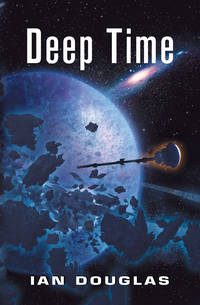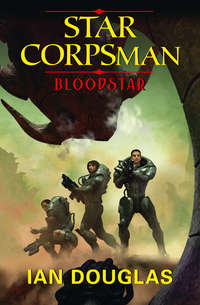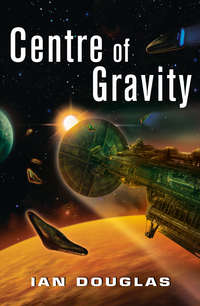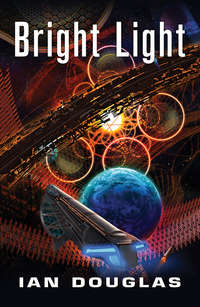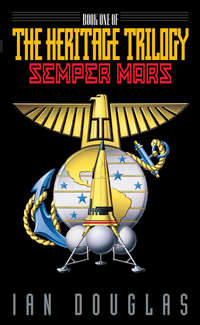
Полная версия
Deep Space
“Having the Nungies parked just sixteen light years from Sol is not my ‘personal problem,’ okay?”
Gregory slapped his left palm down on the table next to his chair, allowing the exposed circuitry woven into the skin across the heel of his hand to come into contact with the table’s linkpad. Coffee, he thought, and added his personal code. A couple of seconds later, the coffee materialized on the receiver plate next to the pad, built up atom by atom so quickly it seemed to flash into solidity out of nothing in an instant. He picked up the mug—cool to the touch, with an animated image of America dropping out of Alcubierre Drive in a dazzling pulse of light—and sipped the coffee—hot enough to scald, with his preference of cream and sugar automatically added.
Cross dropped into the seat next to Gregory’s and ordered a glass of scotch on the rocks. Alcohol would have been unthinkable on board a USNA ship a couple of centuries ago … but the swarms of nano circulating through his body would block damage to his organs, and permit a pleasant buzz without allowing him to get drunk.
“Maybe ‘King’ Koenig doesn’t agree with you,” he suggested after taking a sip.
“The way I heard it, the Confederation bigwigs were in a panic over just how close the Nungies and their friends were. They were pushing for an Osiris relief expedition.”
“Some of them, maybe,” Cross admitted. “And the Chinese want Everdawn back, and the Islamics want Mufrid back and … fuck it. It’s all just politics anyway.”
Gregory nodded in glum agreement. The Confederation seemed glacial in its resolve to win back worlds and systems taken from Sol decades before. There was plenty of talk, sure … talk about Humankind claiming its place among the stars, about systems belonging to humans but now ruled by beings so alien that a meeting of minds with them was virtually impossible. But, somehow, nothing was ever actually done after all of the promises and resolve. The Islamic colony at Mufrid—Eta Boötis IV—was the perfect example. Evacuated when the Turusch had invaded in 2404, Mufrid had been briefly freed a few months later when America and a small fleet returned and raided the system.
But the battlegroup had moved on and Eta Boötis had been abandoned. The evacuees rescued from the planet’s inhospitable surface, some thousands of them, had been shipped back to Sol and ultimately transferred to refugee camps on Luna and within the Islamic Theocracy on Earth, where they remained to this day—still waiting.
It was all so … stupid.
Despite the clamor in some quarters of the Confederation itself, the Directorate in Geneva appeared to be in no hurry to reclaim Osiris or any of the other worlds taken from Confederation control during the past half century. As Cross had pointed out, it was all about politics. Neither the Theocracy nor the Chinese Hegemony were members of the Earth Confederation. Both, in fact, had been enemies of the Confederation at various times over the past few centuries, and Geneva certainly was not going to take care of their territorial issues with aliens before their own problems were addressed.
Confederation, Theocracy, Hegemony, and the Independents—none seemed able to confront the Sh’daar clients as a united front, as Humankind rather than a ragged confusion of separate nation-states.
“So,” Gregory said, “you coming in with me?”
Cross downed the last of his drink and made a face. “Might as well. They’re not letting us off the damned ship, that’s for sure.”
“All liberty cancelled,” Gregory said. “I know.”
“I can see calling back the guys who might’ve gone Earthside or out to Luna. But why do they have to lock us up like we were prisoners, or something?”
Gregory shrugged. “You played the sexinteractives at Angelo’s lately?”
“Yeah, man. Hot. You’re not only there, smack in the middle of the fantasy of your choice, but it feels like your nerves are ’cubing on double capacity.”
“Yup. Direct nanostimulation of the midbrain to stimulate a dopamine dump. Instantly addictive. Maybe they just don’t trust us to come back to the ship.”
“Aw, it’s harmless as long as you’re pumped full of anti-a,” Cross said. “Battlegroup Command is just on a power trip, is all.”
“Or,” Gregory said, settling back in the chair and closing his eyes, “maybe they just want to make sure we review this stuff.” He brought his palm down on the contact plate and relaxed.
He had to deliver a mental code group, to get clearance. The information he was downloading came from the Agletsch, by way of Naval Intelligence, and was not for public access.
After a moment, the data began scrolling past his mind’s eye.
Executive Office, USNA
Columbus, District of Columbia
United States of North America
2034 hours, EST
“What the hell do your … masters think they’re doing?” Koenig demanded.
He was in a virtual conference, standing in a … place, a world with towering mountains of ice on the horizon, and a night sky ablaze with the shifting green and red hues of a spectacular aurora. Stars gleamed, myriad pinpoints peeking through the auroral haze, and the intricate clots and twists and curlings of the Milky Way stretched across the zenith.
It was a real place, Koenig knew, a Confederation colony established in 2294 by settlers from North America and Russia. Themis was the human name for the cluster of cities on the great southern continent of Zeta Doradus V, some thirty-eight light years from Sol. The place was surprisingly Earthlike in a galaxy of hundreds of billions of planetary bodies, most of which were quite different, quite alien from Earth. A living, vibrant world of vast oceans, violet forests, and brilliant sunlight, Zeta Doradus was best known as the place of First Contact—Humankind’s first meeting with an extrasolar species.
Two of them—Gru’mulkisch and Dra’ethde—stood before Koenig now, looking up at him with almost comical twists to their stalked eyes—four apiece, rising from the spidery, flattened, sixteen-legged bodies covered in a velvety-brown leather patterned with gold and blue reticulations. Humans called them “bugs” or “spiders,” but in fact they were not much like either, with unsegmented bodies, an unpleasant mode of eating through their bellies, and sixteen limbs—short at the back and quite long at the front. Both were female; their male companions, like the mates of female Angler fish on Earth, were small parasites attached to their bodies. Properly, the beings were known as Agletsch.
“The masters have told us nothing, President Koenig,” Gru’mulkisch said, speaking through the small translation device affixed to what might approximate its chest. “It is not in their nature to do so, yes-no?”
“Are you certain that the attackers at Omega Centauri were Sh’daar?” Dra’ethde added. “Others might use the ancient transport systems. Others occupy the Great Deeps of the stars.”
Koenig glared at the two small aliens. He’d known these two particular individuals for a long time, ever since he’d commanded CBG-18. When the fleet had departed for Operation Crown Arrow, striking deep into Sh’daar space in order to buy time for a desperate Earth, he’d taken them along as native guides.
It was still difficult sometimes to follow how they thought. Their social conventions were strange—their need for privacy when they ate, for example. These two seemed to have been around forever, and had aged, outwardly at least, not at all. He didn’t know how their life span compared with that of humans. Were they still young? Old? Did age even make a difference for entities so alien, so different physically and emotionally from Humankind?
Generally, the Agletsch seemed friendly, unassuming, and at times eager to help … though they were not always forthcoming with important information. The Agletsch were interstellar traders. What they traded was information, exchanging data about star systems and life forms and interstellar civilizations for information about Earth and humanity, occasionally leavened with the stores of heavy elements that appeared to be a common medium of trade throughout the known galaxy, in particular platinum, iridium, rhenium, as well as some of the longer-half-lived artificials—neptunium-237, and californium-251.
And they gave nothing away for free.
“There are times,” Koenig told them, “when we do not ask you to sell us information because we do not know what to ask. If there is a threat to my species—whether it’s the Sh’daar or some other predatory race out there, I want to know about it.”
“This we understand, Mr. President Koenig,” Dra’ethde told him. “And if we had something definite to trade to you on the matter, we would be certain you were aware of the fact, yes-no? But in this instance we are … bleep!”
Koenig smiled. Agletsch translators sometimes encountered concepts they couldn’t handle in English, and the result was a brief, shrill, electronic tone. In twenty years, the Agletsch had gotten a lot better with English, but they still occasionally bleeped out.
“We are as ignorant as are you,” Gru’mulkisch supplied.
“I see.” Agletsch translations could also sometimes come across as blunt to the point of rudeness.
“The destruction of your Endeavor,” Dra’ethde continued, “may well have been caused by Sh’daar forces … possibly by elements of the Sh’daar Network in disagreement with current policies.”
“The Sh’daar don’t speak with one voice?” Koenig said, feigning surprise. “How very … human! I never would have thought it of them!”
“The Sh’daar Network is unimaginably vast,” Gru’mulkisch told him, missing the irony in Koenig’s voice, “extending, as it does, across a large part of this galaxy, and across an immense gulf of time. There can be, there often is … dissonance among disparate parts of the system.”
“They have my sympathies,” Koenig said with dry amusement.
Who speaks for Earth? That had been the cry of Carl Sagan, a late-twentieth-century cosmologist and philosopher. After four centuries, it was still an open question. It was interesting that the galaxy-spanning Sh’daar, unimaginably more advanced than Humankind, had the same problem.
“What you call the Black Rosette, however,” Dra’ethde said, “remains a mystery to us. Over hundreds of millions of years, it has evolved into something quite beyond its builders’ original intent … beyond even their imaginings, yes-no?”
“Evolved how?”
The two Agletsch went into a momentary huddle, conversing with each other in a rapid-fire burst of eructations. Native Agletsch speech was produced by a kind of controlled belching impossible for humans to imitate. Their translation devices handled English fairly well … and also translated burps to Drukrhu, an artificial trade pidgin that had established the Agletsch as the galaxy’s premier data traders, diplomats, and interspecies liaisons.
The two faced Koenig again. “Since there is no certainty,” Gru’mulkisch said, “since the information is largely supposition, we expect only first-level compensation.”
Koenig opened a window in his mind and entered a thoughtclicked notation. Trade with the Agletsch was based on a well-established scale of prices for specific types of information. Some things—a complete description of a previously unknown alien star-faring civilization, for instance, including their location within the galaxy and a description of their world, were classified as Level Eight, and had a base price of some tens of tons of rhenium, or slightly less of artificial heavy elements. If Geneva could add new information to the exchange, the price in metals came down … but in fact there was surprisingly little that Humankind knew that the Agletsch did not. Earth depended on heavy metals as the medium of exchange with the interstellar trading network.
And as head of the USNA, Koenig had to check large transfers of metal with the government in Geneva.
This time, though, he could make the decision by himself. Level One information could be obtained for only a few hundred kilograms of rhenium or iridium, an amount easily within the reserve capabilities of North America.
“Done,” he said. “Is half platinum, half iridium okay?”
“Satisfactory,” Gru’mulkisch said. “As you put it … done.”
“You are aware, of course,” Dra’ethde told him, “of the Six Suns located within the N’gai Cloud of nine hundred million years ago …”
The virtual panorama around Koenig shifted, showing now a view recorded by the America twenty years earlier, within the core of Omega Centauri T-0.876gy. The planetary surface was gone, and Koenig now drifted in open space, a space completely filled by brilliant stars. Ahead, six particular stars blazed in a hexagon flattened by an off-center viewing perspective, each blue-hued and intensely brilliant. They burned so brightly that the near-solid wall of millions of bright background stars faded into the haze of light, lost in the glare.
Looking away, Koenig saw silhouettes against the encircling haze—several small worlds visible as perfectly black disks, along with a number of smaller, more complicated structures—deep-space factories or bases, perhaps—along with several immense starships. Two minute knots of gold and blue-white fuzz marked a pair of artificial singularities—Sh’daar Nodes leading to other, distant locations in space and time.
“Of course,” Koenig said. The image, he realized, was being stopped down to tolerable levels by the software running this digital illusion. Had he been seeing those brilliant stars as they really appeared from that distance—roughly 300 million kilometers, two thousand times the distance between Earth and Sol—he would have been immediately, searingly blinded.
“These stars,” Dra’ethde continued, “were artificially created by merging lesser, older suns together, yes-no? Each of those stars masses some forty times the mass of your Sol. They were positioned roughly fifty astronomical units from one another, and set into motion about their common center of gravity.”
Koenig nodded understanding. Human astronomers had known of the phenomenon within globular clusters called “blue stragglers” for centuries. Stars were so close-packed within the heart of such clusters that collisions were fairly common at the core. When two ancient red giants merged, they formed a single new star, a blue-hot stellar resurrection, young and hot, an anomaly among millions of ancient red suns.
“The ur-Sh’daar,” Gru’mulkisch said, “engineered the merging of old stars to create more massive, younger stars. Our supposition is that they created the stellar hexagram you see here to create multiple gateways through space and time.”
“The rapid rotation of these super-massive stars would distort the region of space between them,” Dra’ethde added, “opening a myriad of what you call wormholes, and allowing rapid passage from one region of spacetime to another.”
“We’d already figured that much out twenty years ago,” Koenig told them. There was even a term for the process now: stellarchetecture, using entire stars to build artificial structures or devices on a literally astronomical scale. “But the TRGA cylinders—the Sh’daar Nodes—those already do that. How are the Six Suns different?”
“A Sh’daar Node is only about one of your kilometers wide,” Dra’ethde told him, “and involves the mass of one star the size of your sun. The hexagon of six stars is nearly one hundred of your astronomical units across … roughly fifteen billion times larger than a TRGA cylinder, and with a total system mass of two hundred forty of your suns. The number of distinct and separate spacetime paths through the volume defined by the Six Suns is not infinite, but may be a number so large as to be indistinguishable from infinity in any practical sense.”
“We estimate ten to the twenty-six distinct spacetime pathways,” Gru’mulkisch said.
Koenig gave a low whistle. One octillion paths. That was more than any survey could possibly map, a number that might as well be infinite. “Why would they want so many?” He asked.
“In part,” Dra’ethde said, “the Six Suns were designed as a cultural center, a kind of monument to the greatness of ur-Sh’daar technology and power. There is also evidence that they were … experimenting with the structure space.”
“Experimenting how?” Koenig asked.
“We believe that the Six Suns served as a portal to other destinations than ordinary spacetime,” Gru’mulkisch told him. “They may have been trying to reach another universe, another brane altogether.”
The shock of the cold statement was like a blow. They’d been trying to reach not just a remote region of space and time, but another universe?
For centuries, now, cosmologists had hypothesized a large number of universes—possibly an infinite number—existing side by side within a kind of higher dimension or hyperspace physicists called the bulk. Each universe in this series was called a brane, from membrane, and appeared flat—two-dimensional, like a sheet—from the perspective of the bulk, but three-dimensional and coexistent with the other universes when viewed from within. Such a “universe of universes” was called the multiverse.
By definition, those other universes were forever unreachable, completely unconnected with the familiar universe of Sol and Earth and all that Humankind knew. Each existed as a self-contained and isolated sphere of existence with its own set of physical laws, its own nested set of time lines, its own reality. This was something quite different from the more familiar branching of reality invoked in discussions of time travel in order to exorcise the dreaded grandfather paradox. Such branching universes—the so-called many-worlds solution to the Copenhagen Interpretation of quantum physics—were accessible if time travel into the past was possible. Koenig himself had proven that accessibility by reaching Omega Centauri T-0.876gy.
Whether unreachable branes or the accessible temporal branches of a quantum tree properly described the multiverse—or whether reality somehow incorporated both types of parallel universes—was still a matter of heated discussion. Physicists had proven the existence of alternate universes in the mid twenty-first century by showing that some types of subatomic particles that seemed to vanish from this universes in fact had moved … someplace else, but they still argued about what might be on the other side.
By definition, there was no way to reach another brane, and yet Gru’mulkisch was telling him that the ur-Sh’daar had managed to do so … or at least that they’d tried. The mere fact that they’d attempted it said something profound about the level of that civilization’s technology … and about their understanding, their mastery of the cosmos.
“So … I was asking you about the evolution of the Six Suns,” Koenig said after digesting this information. “We’ve already figured out that the Black Rosette is what the Six Suns turned into … evolved into. Stars with forty times the mass of Sol would be ephemeral … a lifetime of only a few million years.”
The more massive a star, the greater the pressures within its core, and the faster it burns through its supply of hydrogen before detonating as a supernova or, for the most massive stars, as an even more powerful hypernova. What’s left after the explosion is most of the star’s mass compacted down to a black hole, a singularity with gravity so powerful that not even light could escape.
“Yes,” Gru’mulkisch said. Her four stalked eyes twisted in a dizzying and untranslatable pattern. “We’re not sure how long the Six Suns existed in their original configuration. The ur-Sh’daar built them, merging sun with sun over the course of millions of years to keep them burning. The Sh’daar, however, apparently lost this technology and, eventually, all six of the stars aged, exploded, and collapsed. Over many more hundreds of millions of years, the black holes descended into tighter and faster orbits, until they became what you call the Black Rosette.”
“The Black Rosette,” Dra’ethde added, “covers a much smaller area of space, of course. However, the gravitational vortices it generates are, we calculate, much more numerous, much more far reaching than the ur-Sh’daar originally planned.”
“More than an octillion spacetime pathways?”
“Considerably more. It may reach across a large portion of the multiverse, and involve both the creation and the destruction of this universe.”
Koenig was silent for a long moment. When he didn’t respond immediately, Gru’mulkisch added, “We told you that much of this is supposition on our part.”
“I know,” Koenig said. “I was just realizing what it was like to be a small child getting his first glimpse of a quantum power tap.”
“I do not understand,” Gru’mulkisch said.
“It looks so pretty,” Koenig said, “with that blue glow surrounding a couple of orbiting microsingularities … but I’m a kid and I have no idea at all what it does, how it works … and I don’t realize that if I’m not very careful, it could swallow me whole.”
Chapter Five
10 November 2424
Sh’daar Node
Texaghu Resch System
210 Light Years from Sol
1024 hours, TFT
Red Mike fell clear of the TRGA cylinder’s entry, once again back in Time Now. Ahead, the Marine light carrier Nassau waited with her escorts. Mike sent the coded, tightly compacted message declaring his arrival and accelerated for home.
“Welcome back, Red Mike,” a voice said within the probe’s consciousness. “Happy birthday!”
It took Red Mike several seconds to decide what the officer on board the carrier was talking about. AI reconnaissance probes are not in the habit, after all, of thinking about birthdays.
But he could reason, within certain parameters, and he did possess a simple outline of history within his files, designed to give him both context and a framework for his conversations with humans. The date—November 10—was the 694th anniversary of the creation of the original Continental Marines, at Tun Tavern, Philadelphia in 1775. The later United States Marines and, now, the USNA Marines, continued the tradition of observing this date with what amounted to a religious fervor, celebrating it with parades, speeches, cake cuttings, and formal balls wherever possible. The Nassau, a tiny microcosm of the Corps with several thousand Marines embarked on board, was no exception.
Red Mike was as incurious about human traditions and customs as he was about anything else not specifically within his purview, but the birthday greeting did raise one question. If the Marines were busy cutting cakes and making speeches … were they ready for what appeared to be gathering just on the other side of the Sh’daar Node?
TC/USNA CVS America
USNA Naval Base
Quito Synchorbital
0840 hours, TFT
Gray was in his office going through the daily briefings when Rear Admiral Steiger’s avatar entered Gray’s inward awareness. “Excuse me. Sandy?”
“Yes, sir?”
“I’ve been directed to link with Geneva for a strategic conference. I’d like my flag captain there with me.”
“Yes, Admiral. That sounds promising. You think we’re getting our flight orders?”
“I do. The question is, what’s our destination?”
Gray gave a mental shrug. “Seems fairly obvious to me, sir. All of those simulations of a deployment to Omega Cent we’ve been running … and then we get word of the Endeavor.”
“Maybe … maybe. Unless the Confed Senate decides we need to block the Slan at 36 Oph. But the real question may be when is our destination?”
“Through the TRGA? Maybe so. But we’re going to need more than a carrier battlegroup to take on the Tee-sub minus Sh’daar. When is the linkup?”




